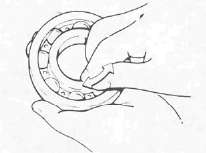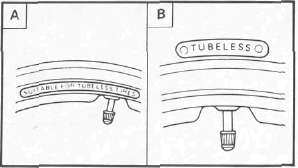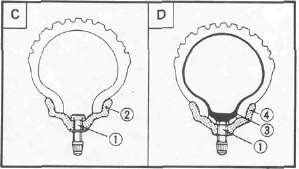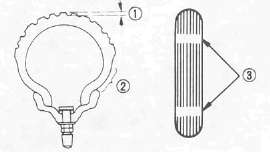Front Wheel Bearings
1. Raise the front end of the motorcycle, and spin the wheel by hand. Touch the axle or front fork white spinning the wheel. Replace the bearings if any vibration is detected.
Note: It may be necessary to retract the brake pads from the disk in order to freely rotate the wheel.
Rear Wheel Bearings
1. Remove the rear wheel

2. Check the bearing movement by rotating it with the fingers. Replace if any roughness or wear is detected.
TUBELESS TIRES AND ALUMINUM WHEELS
WARNING:
Always inspect aluminum wheels before a ride.
Do not attempt any repairs to the wheel; replace any defective wheel.
Do not attempt to use tubeless tires on a wheel designed for use with tube-type tire only. Tire failure and subsequent personal injury may result from sudden deflation.

|
A | Wheel |
B Tire |
|
Tube type |
Tube type only |
|
Tubeless |
Tube type or tubeless |
• Be sure to install the proper tube when using tube-type tires.
• New tires have a relatively poor adhesion on the road surface so do not allow them to be subjected to high speed load from maximum speed until after a break-in run of approx. 100 km (60 mi).
• Always use the correct tire inflation pressure according to the operating conditions.

(C) Tubeless tire
(D) Tube type tire
(1) Air valve
(2) Aluminum wheel {Tubeless type)
(3) Tube
(4) Aluminum wheel (Tube type)
Always perform the following steps to ensure safe operation, maximum tire performance and long service.
1. Measure the tire pressure and adjust as necessary.
|
Basic weight: With oil and full fuel tank |
232 kg (511 lb) |
|
|
Maximum load-*- |
238 kg (525 lb) load |
|
|
Cold tire pressure |
Front |
Rear |
|
Up to 90 kg (198 1b) load* |
177 kPa (1.8 kg/cm2, 26 psi) |
196 kPa (2.0 kg/cm2, 28 psi) |
|
90 kg (198 1b) load ~ 238 kg (525 lb) |
196kPa (2.0 kg/cm2, 28 psi) |
275 kPa (2.8 kg/cm2, 40 psi) |
|
High speed riding |
206 kPa (2.1 kg/cm2, 30 psi) |
226 kPa (2.3 kg/cm2, 32 psi) |
* Load is the total weight of cargo, rider, passenger, and accessories.
2. Inspect the tire surfaces for wear or damage. Replace as required.
Minimum Tire Tread Depth: (Front and Rear) 1.0 mm (0.04 in)

(1) Tread depth
(2) Side wall
(3) Wear indicator
3. Inspect the aluminium wheels for damage or cracks. Never attempt even small repairs to the wheel.
NOTE:
Always balance the wheel when a tire or wheel has been changed or replaced.
WARNING:
Ride conservatively after installing a tire to allow it to seat itself properly on the rim.
- Printer-friendly version
- Log in to post comments
